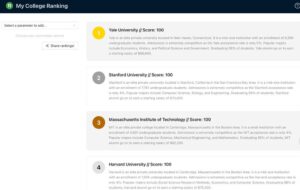High school students across the BASIS International & Bilingual Schools · China (BIBS · C) network showcased their coding skills at the recent BIBS · C Network Hackathon. This multi-day virtual event challenged participants to explore the theme of “order” by creating projects related to simulation, organizational tools, and computer engineering.
The students’ creativity, technical skills, and problem-solving abilities were evident in the high quality of their submissions. Projects ranged from an intuitive screen brightness control system and traffic light simulation to a personalized college ranking tool and a visualization demonstrating the concept of gravitational distortion.
With so many outstanding projects, the judges faced the difficult task of selecting the top submissions. A few projects emerged as the winners after a rigorous round of individual and group assessments.
Hackathon Rankings
First Place
Michael L.
BASIS International School Park Lane Harbour

My program, Gesture-Based Brightness Adjuster, is designed to dynamically adjust the brightness level of a computer screen based on hand gestures detected using a webcam. This program is written in Python and developed using the PyCharm Integrated Development Environment. The core functionality relies on detecting the distance between the thumb and the index finger and using the pinky finger curl as a trigger to set the brightness to a fixed value. This program utilizes several libraries: OpenCV for video capture and image processing, MediaPipe for hand detection and tracking, NumPy for numerical operations, and the screen_brightness_control library to adjust the screen brightness. By providing an intuitive and contactless way to control screen brightness, this program helps maintain hygiene in environments where reducing physical contact is important, such as hospitals, clean rooms, or during pandemics.

Second Place
Vicky L.
BASIS International School Hangzhou

My project simulates the work of traffic lights and adjusts the number and duration of each light’s cycle. The inspiration came from frequently encountering broken traffic lights on my way to school, which drove me to learn about their internal structure. Building the circuit board, the breadboard, and the wiring was the most challenging part, even though I had learned about the theory of circuit boards. The traffic light simulation is realized through the Python module in Thonny. I programmed rules for left turns, straight paths, and right turns based on Chinese traffic regulations, which can automatically adjust the traffic flow during different periods. During rush hour, the red light lasts longer, while at midnight, the green light is longer.

Third Place (tie)
David W.
BASIS International School Nanjing

Many high school students struggle to find the right college. They often rely on college rankings, such as the U.S. News Best Colleges, to help them make their decision. However, these rankings are often based on criteria that may not be relevant to the student. My College Ranking (MCR) is a web application that allows users to create their own college rankings based on their own standards. Users can add parameters to their ranking and rank colleges using these criteria. They can also view other users’ rankings and share their own.
The website is deployed at https://mcr.onrender.com/.
The source code is available on GitHub

Third Place (tie)
Harry L., Mcqueen Z., Kyle C.
BASIS International School Shenzhen



This project aims to simulate and visualize the incredible nature of general relativity. It uses Three.js with the application of HTML; the program itself demonstrates the concept of gravitational distortion. The dynamic space-time distortion is simulated with the size of the sphere, which is adjustable and responsive. This topic is interesting not only for students but also for general viewers because it provides an understandable visualization without complex context.
Please feel free to explore and interact with the visualization:
https://ygmssmgy.github.io/Hackathon/

Honorable Mention
Angelina J.
BASIS International School Shenzhen

The GPA Calculator, as its name suggests, calculates a student’s GPA. The program starts by automatically creating six subjects with random grades. The user can edit or delete a subject or add a new one. The user must input the subject name (the system prevents the user from inputting an already created subject, case-sensitive) and scores for each assignment in the subject. The subject contains three categories with different weightings — classwork and homework (25% each) and tests (50%). A subject average score is displayed at the bottom of the subject page. After inputting the scores, the user can choose to cancel (return to the main page and delete the subject that was just created) or save (the subject will automatically show up on the main page, updating the total GPA)

Hackathon Conclusion
Congratulations to our winners, and thank you to all the student hackers who submitted projects for the BIBS · C Network Hackathon. We wish all the best as you perform traversals through your academic career. We look forward to seeing your development next year at the second annual BIBS · C Network Hackathon! Happy Coding!
Learn more about career opportunities with BASIS International Schools on our careers website.